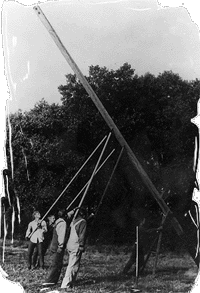Our History
Guernsey-Muskingum Electric Cooperative
 In the 1930’s, electricity was common -- as long as you lived in the city. The countryside
was in the dark. The big city power companies were willing to provide the needed
amenities of the period, as long as you lived in the city.
In the 1930’s, electricity was common -- as long as you lived in the city. The countryside
was in the dark. The big city power companies were willing to provide the needed
amenities of the period, as long as you lived in the city.
Out in the farmlands, the farmer could not use an electric pump. He had to milk
his cows by hand. He didn’t have an electric feed grinder and he had to stick hundreds
of ears of corn into a grinder and crank it by hand for hours in order to provide
feed for his mules and horses. The lucky ones could use a noisy gas engine to power
some of their farm equipment. The farmer had to stumble through the barn by kerosene
lamplight if he had to work after sunset. In the home, washing, ironing, cooking,
canning, shearing all had to be done by hand using the same methods that were used
by the farm wife's mother and grandmother. Water was pumped and carried by hand.
Light came from oil or kerosene lamps. Wood or coal stoves heated homes, water and
food.
In the city, laborsaving devices were greatly improving the quality of life. Because
there was no electric service for those living in rural areas, electricity was becoming
the great divider between the city and the country. One part of the nation lived
in light, the other in darkness. One class was enlightened; the other class was
backward. The chasm was growing.
The farmers wanted electricity. However, privately owned power companies said serving
rural areas would be too costly because the houses were too far apart and farmers
would not use much electricity. Farmers would have to stay in the dark because there
was no profit to be made in serving them.
Under President Franklin D. Roosevelt, the Rural Electrification Administration
(REA) was formed in 1935 to administer a program to encourage rural electrification
by lending low-interest money (equal to the government's cost to borrow money) to
any group or company that would undertake the task. Even with the offer of low-interest
financing, almost all of the private electric companies chose not to get involved.
Instead, the farmers decided to form the cooperatives to do the job themselves.
On April 4, 1938, a group of Rural Electrification Association Committeemen from
Muskingum, Guernsey, Tuscarawas, Morgan, Noble Counties met in New Concord, Ohio.
The group voted to incorporate. The name of the association was Guernsey-Muskingum
Electric Cooperative, Inc.
Construction began in April 15, 1939 and the first few miles of lines were energized,
to provide electric service to a handful of consumer-owners.
Since then, the Cooperative has grown and its membership has become quite diverse.
The Cooperative serves over 16,799 consumers in Guernsey, Muskingum, Tuscarawas,
Morgan, Noble, Harrison, Coshocton, Licking and Perry counties. Guernsey-Muskingum
maintains over 2,806 miles of underground and overhead lines. The Cooperative office
is located at 17 South Liberty Street, New Concord, Ohio.